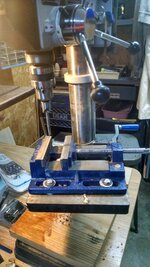Quillpig
Member
Hi,
We got my son a lathe and some pen turning supplies for Christmas, and we're trying to teach ourselves (with the help of YouTube and this forum). We've run into a few issues and I was hoping for some feedback from the group.
The first issue we ran into was related to gluing the brass tubes into the wooden blanks. We drilled out the blanks with the 7mm bit that came with our kit (from Rockler). The tubes seemed to be a loose fit, so I used plenty of CA glue (again, from the kit) and made sure that the whole tube was well coated, and I stuck it into one side of the hole, swirled it around, and then stuck in in the other side of the hole. We allowed 24 hours for curing. Still, three of the 8 tubes came loose when I used the flush trim bit to even up the end of the blank with the end of the tube.
We re-glued those with 5-minute epoxy, again allowing 24 hours to cure, and one of the three still came loose.
Should the fit be more snug? Are my (cheap) tubes a little too small? Am I using bad glue technique? Is this failure rate par for the course?
I have several other issues, but I'll ask those questions later.
Thanks for all your help!
Sent from my iPad using Tapatalk
We got my son a lathe and some pen turning supplies for Christmas, and we're trying to teach ourselves (with the help of YouTube and this forum). We've run into a few issues and I was hoping for some feedback from the group.
The first issue we ran into was related to gluing the brass tubes into the wooden blanks. We drilled out the blanks with the 7mm bit that came with our kit (from Rockler). The tubes seemed to be a loose fit, so I used plenty of CA glue (again, from the kit) and made sure that the whole tube was well coated, and I stuck it into one side of the hole, swirled it around, and then stuck in in the other side of the hole. We allowed 24 hours for curing. Still, three of the 8 tubes came loose when I used the flush trim bit to even up the end of the blank with the end of the tube.
We re-glued those with 5-minute epoxy, again allowing 24 hours to cure, and one of the three still came loose.
Should the fit be more snug? Are my (cheap) tubes a little too small? Am I using bad glue technique? Is this failure rate par for the course?
I have several other issues, but I'll ask those questions later.
Thanks for all your help!
Sent from my iPad using Tapatalk

